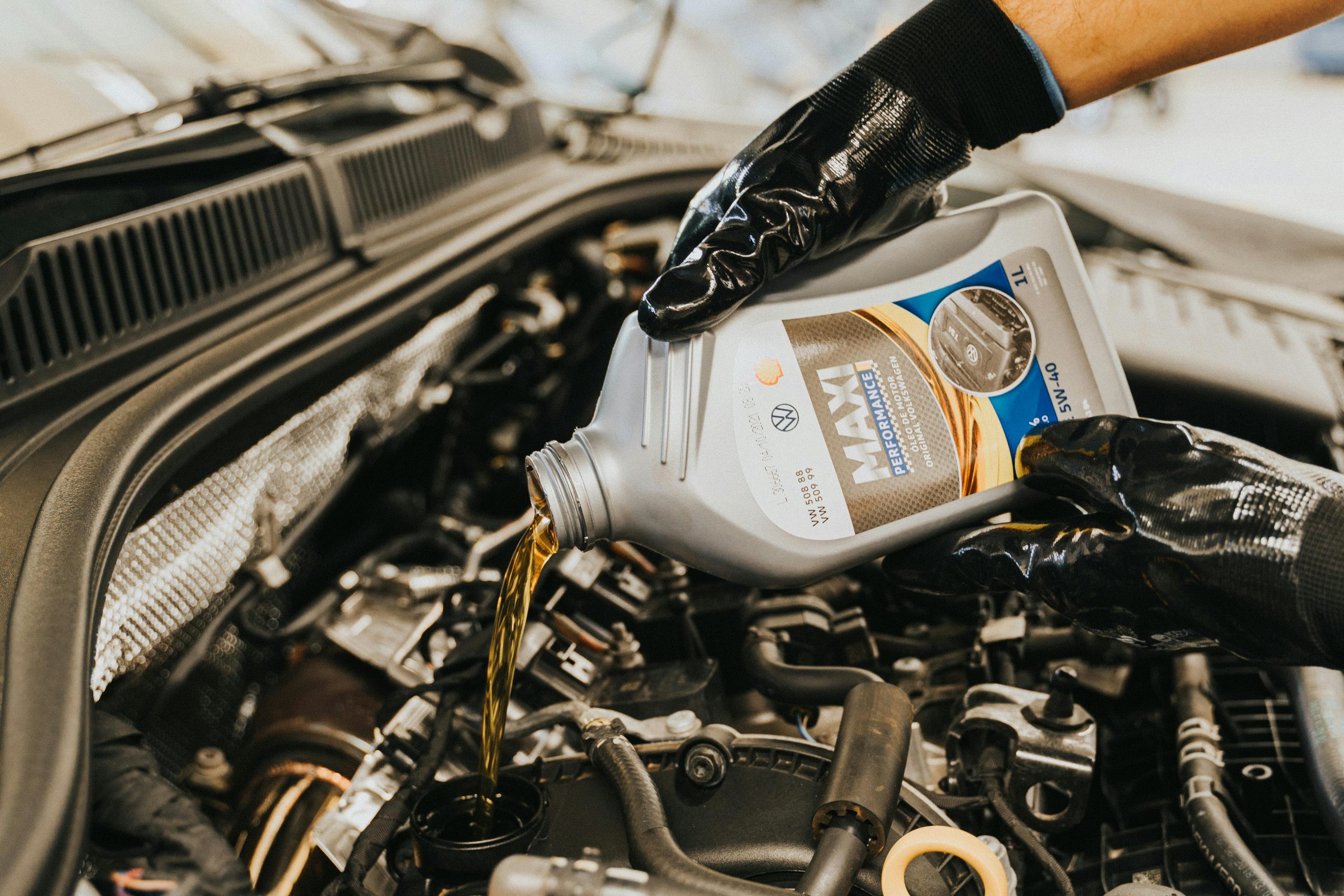There are many important ways of maintaining your vehicle throughout the year – and having the correct engine oil is just one of them. An engine oil check is a key part of car maintenance and you should be aware of what it does, what type you need, and how to top it up.
There are many different types of engine oil, and it can be confusing to know which one your car needs. This guide highlights the differences between the oils and what they do.
What does engine oil do?

Engine oil is used to lubricate the moving components of a vehicle. The engine itself generates immense amount of heat, and proper lubrication enables all the different parts to move successfully without generating dangerous levels of friction.
If there isn’t the right oil – or enough of the correct one – then it could lead to serious damage to your vehicle.
The oil also works as a cleaner for the engine. It collects dirt and dust, making the engine safer and more efficient.
Motor oil can also improve fuel economy, cool the engine, and reduce emissions.
Depending on the type of oil your vehicle requires, you should consider its additives. Additives are chemicals that are added to the oil to improve its performance. Common additives include detergents, dispersants, and anti-wear agents. These additives can help keep your engine clean and running smoothly.
Below are the different types of engine oil you can get for your vehicles.
Engine oil types
Synthetic
Synthetic motor oil is a type of oil that is designed to provide better performance than traditional motor oils. It is made from a variety of synthetic materials, including polyalphaolefins (PAOs) and esters.
This type of motor oil is often used in high-performance cars and in cars that require extended oil change intervals.
Semi-synthetic
Semi-synthetic motor oil is a blend of synthetic and mineral oils. It is designed to provide better performance than mineral oil, while also being more affordable than full synthetic oil.
It is a good choice for drivers who want the benefits of a synthetic oil, but don’t want to pay the higher price.
This oil is also a good option for vehicles that are not driven very often, or that are used for short trips regularly.
Mineral
Mineral motor oil is a lubricant that is made from crude oil. It is a non- synthetic oil, meaning that is not made from chemicals.
It is the most common and affordable type of motor oil. Mineral oil is a natural product, is non-toxic and biodegradable, and prolongs the life of your engine.
Low SAPS
If you’re looking for a low-SAPS motor oil, there are a few things you need to know.
SAPS (or sulphated ash, phosphorus, and sulphur) are additives that are used in motor oil to help protect the engine.
However, too much of these additives can actually do more harm than good. That’s why it’s important to choose a motor oil that is specifically labelled as low-SAPS.
Some of the best low-SAPS motor oils on the market today include Shell Rotella T6, Mobil 1 ESP Formula 5W-30, and Pennzoil Ultra Platinum 5W-30.
All of these oils meet or exceed the requirements of the latest engine protection standards, and they provide excellent protection for your engine even in extreme conditions.
High-mileage motor oil
High-mileage motor oil is a type of motor oil specifically designed for vehicles with over 100,000 miles on the odometer.
It is formulated to provide extra protection for older engines, which may be more prone to wear and tear due to age. Also, it is typically thicker than conventional motor oil, and contains additives that help reduce oil consumption, reduce leaks, and reduce engine deposits. It also helps to decrease friction and wear, and can help extend the life of your engine even further.
When choosing a high-mileage motor oil, it is important to select one that is specifically designed for your vehicle. Many high-mileage motor oils are formulated for specific makes and models, so it is important to read the label carefully to make sure you are getting the right product for your vehicle.
It is also important to follow the manufacturer’s recommended oil change intervals, as high-mileage motor oil may need to be changed more frequently than conventional motor oil.
What do the numbers in oil grades mean?

The most common types are 10W-30, 5W-30, and 0W-20.
10W-30 is a conventional oil that is suitable for most cars. It is a good all-around choice that provides good protection for both hot and cold weather.
5W-30 is a synthetic oil that is also suitable for most cars. It is thinner than 10W-30, which makes it a good choice for cars that operate in cold weather.
0W-20 is a synthetic oil that is designed for cars that require the thinnest oil possible. It is not recommended for cars that operate in hot weather, as it may not provide enough protection.
However, there can be many different variants.
An engine oil with numbers either side of the ‘W’ is known as multigrade oil. These are specific oils that are designed to deal with seasonal temperature.
Most vehicles in the UK use multigrade oils and are the most common type of engine oil available to buy. These oils keep your car running throughout the year and in all weather conditions.
If the oil is not marked with a ‘W’, then it is designed for driving in hotter temperatures during the summer months.
Engine oil viscosity
Engine oil viscosity is an important factor to consider when selecting the right motor oil for your vehicle.
Viscosity is a measure of a fluid’s resistance to flow. The higher the viscosity, the thicker the oil and the slower it will flow. The lower the viscosity, the thinner the oil and the faster it will flow.
The viscosity of motor oil is measured using two numbers, such as 10W-30. The first number, 10W, is the viscosity of the oil at cold temperatures. The second number, 30, is the viscosity of the oil at hot temperatures. The lower the first number, the better the oil will flow at cold temperatures. The higher the second number, the better the oil will flow at hot temperatures.
It is important to select the right viscosity of motor oil for your vehicle. If the oil is too thick, it will not flow quickly enough to lubricate the engine properly.
However, if the oil is too thin, it will not provide enough protection against wear and tear. The owner’s manual for your vehicle will specify the recommended viscosity of motor oil for your engine.
Make sure to consider the viscosity and type of oil when selecting the right oil for your engine.
Can you mix engine oils?
When it comes to motor oil, it’s important to understand that mixing different types of oil can be dangerous for your car’s engine.
Different types of oil have different viscosities, additives, and other properties that can interact with each other in unpredictable ways. This can lead to sludge build-up, increased wear and tear on engine components, irreparable damage, and other problems throughout the vehicle.
In general, it’s best to avoid mixing different types of motor oil. If you need to top off your oil, make sure to use the same type of oil that’s already in your engine. If you’re changing your oil, make sure to drain the old oil completely before adding the new oil.
If you’re unsure of what type of oil is in your engine, you can check your owner’s manual, consult a mechanic or visit a local trusted garage. They’ll be able to tell you what type of oil is best for your car and how to properly change it.
Will the wrong engine oil damage my car?

If you are looking to change the engine oil in your car – make sure you are using the correct type.
If you end up using the wrong engine oil in your car, it can cause serious damage to your engine.
Engine oil is designed to lubricate the moving parts of your engine, protect against wear and tear, and help keep your engine running smoothly. If you use the wrong oil, it can cause your engine to overheat, leading to serious issues.
Using the wrong oil can also cause your engine to become clogged with sludge, which can reduce its efficiency, and cause it to run less smoothly. The wrong motor oil can also cause your engine to leak.
Check your owner’s manual to find out what type of oil is recommended for your car.
How to top up my engine oil?
Topping up your engine oil is an important part of regular car maintenance. It’s important to use the right type of oil for your car, and to check the oil level regularly.
Here’s a step-by-step guide to topping up your engine oil:
– Park your car on a level surface and turn off the engine
– Open the hood and locate the oil dipstick
– Pull out the dipstick and wipe it clean with a rag
– Reinsert the dipstick and pull it out again to check the oil level
– If the oil level is low, add a small amount of the correct oil into the engine
– Check the oil level again to make sure it’s at the correct level
– Replace the dipstick and close the hood
– Start the engine and check for any leaks
Remember to use the correct type of oil for your car. If you’re unsure, consult your owner’s manual or speak to a mechanic or local garage.
How much oil will my engine take?
The amount of motor oil your engine needs depends on the make and model of your vehicle.
Generally, most engines require between 4 and 6 litres of oil. However, it is important to check your owner’s manual or the manufacturer’s website to determine the exact amount of oil your engine requires.
It is also important to note that the type of oil you use can affect the amount of oil your engine needs. For example, some engines require synthetic oil, which is usually more expensive, but can last longer than other types of oil.
Check your oil level regularly to make sure you have the right amount of oil in your engine. If you find that you are running low on oil, it is important to add more oil as soon as possible to avoid any damage to your engine.
How often should I change my engine oil?

When it comes to changing your engine oil, the general rule of thumb is to do it every 6,000 miles. However, this can vary depending on the type of vehicle you have, the type of oil you use, and how you drive.
For example, if you have a newer car with synthetic oil, you may be able to go up to 7,500 miles before needing an oil change. On the other hand, if you have an older car with conventional oil, you may need to change it more often, such as every 3,000 miles.
It’s also important to consider how you drive. If you do a lot of stop-and-go driving, or if you drive in extreme temperatures, you may need to change your oil more often.
The best way to know for sure is to consult your owner’s manual or talk to your mechanic. They can help you determine the best oil change schedule for your vehicle.
